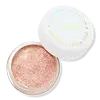What's inside
What's inside
 Key Ingredients
Key Ingredients

 Benefits
Benefits

 Concerns
Concerns

 Ingredients Side-by-side
Ingredients Side-by-side

Water
Skin ConditioningCalcium Sodium Borosilicate
Synthetic Fluorphlogopite
Silica
AbrasiveButylene Glycol
HumectantSorbeth-30 Tetraisostearate
EmulsifyingDipropylene Glycol
HumectantCalcium Aluminum Borosilicate
Aluminum Calcium Sodium Silicate
Polyethylene Terephthalate
Polyurethane-33
Polymethyl Methacrylate
Polybutylene Terephthalate
Acrylates Copolymer
Aluminum PCA
AstringentEthylene/Va Copolymer
Emulsion StabilisingTitanium/Titanium Dioxide
Cosmetic ColorantAlumina
AbrasiveDimethicone
EmollientTriethoxycaprylylsilane
Benzyl Alcohol
PerfumingSorbitan Sesquiisostearate
EmulsifyingAcrylates/Beheneth-25 Methacrylate Copolymer
PPG-8-Ceteth-20
EmulsifyingChlorphenesin
AntimicrobialTin Oxide
AbrasiveDehydroacetic Acid
PreservativeSodium Hydroxide
BufferingPhenoxyethanol
PreservativeHydrogenated Polyisobutene
EmollientPalmitic Acid
EmollientCI 77000
Cosmetic ColorantCI 77163
Cosmetic ColorantCI 77266
Cosmetic ColorantBlue 1 Lake
Cosmetic ColorantCI 42090
Cosmetic ColorantCI 77400
Cosmetic ColorantCI 77289
Cosmetic ColorantCI 77288
Cosmetic ColorantCI 77510
Cosmetic ColorantIron Oxides
CI 77742
Cosmetic ColorantMica
Cosmetic ColorantCI 16035
Cosmetic ColorantCI 77891
Cosmetic ColorantCI 77007
Cosmetic ColorantCI 19140
Cosmetic ColorantWater, Calcium Sodium Borosilicate, Synthetic Fluorphlogopite, Silica, Butylene Glycol, Sorbeth-30 Tetraisostearate, Dipropylene Glycol, Calcium Aluminum Borosilicate, Aluminum Calcium Sodium Silicate, Polyethylene Terephthalate, Polyurethane-33, Polymethyl Methacrylate, Polybutylene Terephthalate, Acrylates Copolymer, Aluminum PCA, Ethylene/Va Copolymer, Titanium/Titanium Dioxide, Alumina, Dimethicone, Triethoxycaprylylsilane, Benzyl Alcohol, Sorbitan Sesquiisostearate, Acrylates/Beheneth-25 Methacrylate Copolymer, PPG-8-Ceteth-20, Chlorphenesin, Tin Oxide, Dehydroacetic Acid, Sodium Hydroxide, Phenoxyethanol, Hydrogenated Polyisobutene, Palmitic Acid, CI 77000, CI 77163, CI 77266, Blue 1 Lake, CI 42090, CI 77400, CI 77289, CI 77288, CI 77510, Iron Oxides, CI 77742, Mica, CI 16035, CI 77891, CI 77007, CI 19140
Water
Skin ConditioningMica
Cosmetic ColorantGlycerin
HumectantSilica
AbrasiveGalactoarabinan
Pentylene Glycol
Skin ConditioningGlyceryl Caprylate
EmollientFructose
HumectantCellulose
AbsorbentKaolin
AbrasiveAesculus Hippocastanum Extract
AntioxidantHonokiol
AntioxidantTin Oxide
AbrasivePotassium Sorbate
PreservativeCitric Acid
BufferingCI 77891
Cosmetic ColorantCI 77491
Cosmetic ColorantCI 77492
Cosmetic ColorantCI 77499
Cosmetic ColorantCI 77007
Cosmetic Colorant
 Reviews
Reviews

Ingredients Explained
These ingredients are found in both products.
Ingredients higher up in an ingredient list are typically present in a larger amount.
This pigment is called Ultramarine blue lazurite. It gives a saturated blue color, but can be used to create other colors as well.
According to the manufacturer, it is usually made from kaolin, sodium sulfate, sodium carbonate, sulfur, and charcoal.
Ci 77891 is a white pigment from Titanium dioxide. It is naturally found in minerals such as rutile and ilmenite.
It's main function is to add a white color to cosmetics. It can also be mixed with other colors to create different shades.
Ci 77891 is commonly found in sunscreens due to its ability to block UV rays.
Learn more about CI 77891Mica is a naturally occurring mineral used to add shimmer and color in cosmetics. It can also help improve the texture of a product or give it an opaque, white/silver color.
Serecite is the name for very fine but ragged grains of mica.
This ingredient is often coated with metal oxides like titanium dioxide. Trace amounts of heavy metals may be found in mica, but these metals are not harmful in our personal products.
Mica has been used since prehistoric times throughout the world. Ancient Egyptian, Indian, Greek, Roman, Aztec, and Chinese civilizations have used mica.
Learn more about MicaSilica, also known as silicon dioxide, is a naturally occurring mineral. It is used as a fine, spherical, and porous powder in cosmetics.
Though it has exfoliant properties, the function of silica varies depending on the product.
The unique structure of silica enhances the spreadability and adds smoothness, making it a great texture enhancer.
It is also used as an active carrier, emulsifier, and mattifier due to its ability to absorb excess oil.
In some products, tiny microneedles called spicules are made from silica or hydrolyzed sponge. When you rub them in, they lightly polish away dead skin layers and enhance the penetration of active ingredients.
Learn more about SilicaTin Oxide is an inorganic oxide used to add opacity and volume to a product. In nature, it is already found in mineral form. The main ore of tin is an opaque and shiny mineral called casseterite.
Tin Oxide helps remove translucency in a product, or make it more opaque. Besides adding opacity, tin oxide is used for bulking to add volume.
Water. It's the most common cosmetic ingredient of all. You'll usually see it at the top of ingredient lists, meaning that it makes up the largest part of the product.
So why is it so popular? Water most often acts as a solvent - this means that it helps dissolve other ingredients into the formulation.
You'll also recognize water as that liquid we all need to stay alive. If you see this, drink a glass of water. Stay hydrated!
Learn more about Water